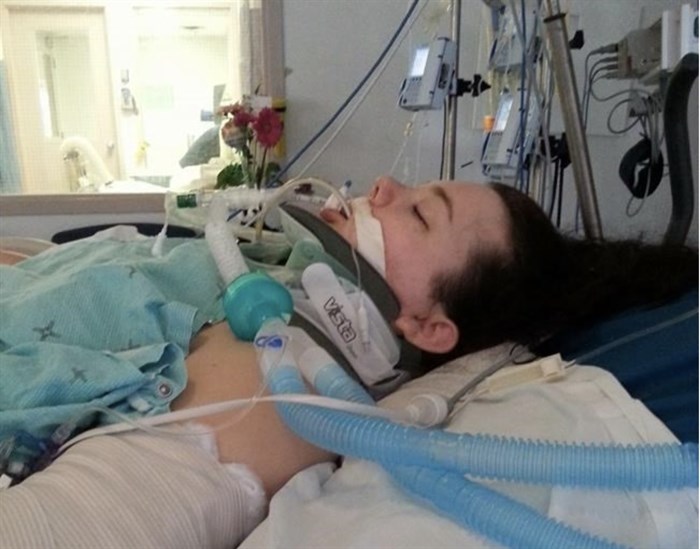
Ashley Ruelland, shown in a handout photo, had countless blood tests and more than 100 blood transfusions after a head-on crash that left her with multiple injuries, but she says it's encouraging to know that drawing less blood is best for patients, based on a large Canadian study.
Image Credit: THE CANADIAN PRESS/HO-The Ottawa Hospital **MANDATORY CREDIT**
October 15, 2023 - 12:00 PM
Intensive care units can collect less blood for lab tests and thereby reduce transfusions for critically ill patients who may have blood drawn multiple times a day, suggests a large study that says switching to lower-volume tubes can preserve the blood supply and reduce strain on already fragile patients.
Researchers note that 90 per cent of blood collected by a standard test tube — which can draw up to six millilitres — is wasted because only 0.5 ml of blood is needed for a typical lab test.
They compared the use of regular and lower-volumetubes for tests involving 27,000 patients at 25 intensive care units in Quebec, Ontario, New Brunswick and Manitoba between 2019 and 2021, minus a five-month delay during the pandemic.
The study, published Thursday in the Journal of the American Medical Association (JAMA), found that using a tube that collects about half the amount provides more than enough blood for a typical lab test. The switch also saved one blood transfusion for every 10 patients in ICUs.
The alternate tubes are physically identical to standard tubes but allow for a smaller draw because they contain less anticoagulants, which prevent blood from clotting, said lead author and hematologist Dr. Deborah Siegal of The Ottawa Hospital.
She said it's one of the reasons standard tubes can't be partly filled. Lower-volume tubes also generate a weaker vacuum pull so automatically draw less blood, she added.
Siegal said about 40 per cent of the sickest patients have repeated lab tests, resulting in significant blood loss that contributes to anemia, or low red blood cells. That leads to more blood transfusions.
Smaller-volume tubes are used mostly in children and don't cost more, said Siegal.
"Literally, the hospital staff went to storage areas in the intensive care units, swapped out the old tubes for the new tubes and put on a new bar code," Siegal said of the study, which she started while at the Population Health Research Institute at McMaster University and Hamilton Health Sciences.
"This was embedded right into practice by people actually doing the job of looking after patients."
The study shows it's time to change protocols in ICUs and elsewhere to prevent excessive blood draws from patients who end up having more transfusions, she added.
"Ninety per cent of the blood that they take is thrown into the garbage. This is a way to reduce transfusion so that (blood) is available for people who need it, for surgeries or cancer treatment. There are ongoing shortages of blood in Canada. This is a worldwide problem."
Patients in the study received more than 36,000 blood transfusions. The small-volume tubes may have saved about 1,500 units of blood, Siegal said. One unit of blood equals half a litre.
Using standard tubes to draw blood from critically ill ICU patients has long been criticized as a wasteful practice. It was even dubbed "ICU vampirism" by Mayo Clinic researchers in a report published a decade ago in the British Journal of Haematology. They suggested hospitals adopt restrictive blood draw protocols.
Ashley Ruelland of Ottawa agrees. She had countless lab tests and more than 100 blood transfusions over a two-month ICU stay after suffering multiple injuries in a head-on crash in March 2015.
Ruelland said doctors ordered blood tests for various reasons, including to determine whether her organs were functioning properly, if she was getting enough nutrients and if she had infections.
"And they were testing for anemia, which seems counterproductive, while I was getting the blood transfusions," said Ruelland, whose vehicle was struck when she was driving the bride-to-be and another friend to a bachelorette party.
"It seems like a no-brainer," Ruelland said of the suggestion that hospitals transition to smaller-volume tubes.
"When I heard about this study I thought of how much less stressful it would have been on my body to have had less blood taken. When I was not sedated, seeing the amount of blood leaving my body was also traumatic after what happened to me."
Dr. Jeannie Callum, a hematologist and director of transfusion medicine at the Kingston Health Sciences Centre in Ontario, said that while blood transfusions are life-saving, they can have negative consequences, including infections and allergic or flu-like reactions.
Callum said she knew about some of the study's findings several months ago and has helped to gradually transition all units at the hospital from standard to "pediatric tubes."
"Last week, the entire hospital got done, everything — outpatients and in-patients, everybody," said Callum, who initially faced some pushback from staff who worried the move might compromise test results.
But she said her experience working with Siegal had convinced her that if such a switch was beneficial in ICUs, it could also be used in other units. Staff at Kingston also spoke with some researchers aboutthe JAMA study, Callum added.
"The paper is a game changer for hospitals because now they know there's no downside. You've got to have a pretty good reason for not doing this."
This report by The Canadian Press was first published Oct. 12, 2023.
Canadian Press health coverage receives support through a partnership with the Canadian Medical Association. CP is solely responsible for this content.
News from © The Canadian Press, 2023